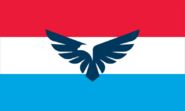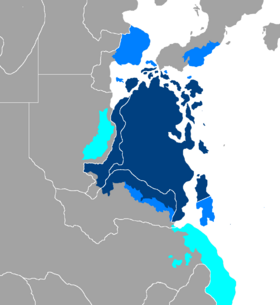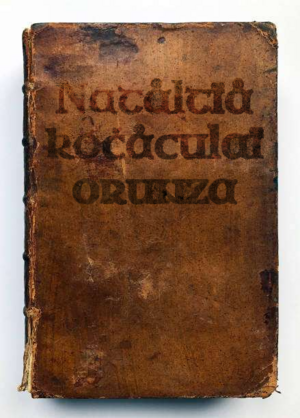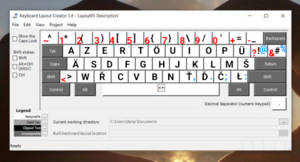Natalician: Difference between revisions
Tags: Mobile edit Mobile web edit Advanced mobile edit |
Tags: Mobile edit Mobile web edit Advanced mobile edit |
||
| Line 70: | Line 70: | ||
During the beginning of the decline of the monarchy, | During the beginning of the decline of the monarchy, | ||
== | ==Etymology== | ||
The name of Natalicia, the Natales and the Natalician language comes from the tribes of Natalo-Kershenian | |||
== Phonology == | == Phonology == | ||
Revision as of 17:34, 17 March 2024
This article is private. The author requests that you do not make changes to this project without approval. By all means, please help fix spelling, grammar and organisation problems, thank you. |
This article is a construction site. This project is currently undergoing significant construction and/or revamp. By all means, take a look around, thank you. |
| Natalician | |
|---|---|
| Nataledhi | |
 Flag of the Natalician Republic | |
| Pronunciation | [na.ta.le.di] |
| Created by | Hazer |
| Date | 2021 |
| Native to | Natalicia; Firenia and the Kontamchian Islands |
| Ethnicity | Natales |
| Native speakers | 37,123,487 (2021) |
Tinarian
| |
| Official status | |
Official language in | Natalicia, Firenia, Budernie, Nirania, Kannamie |
Recognised minority language in | Espidon, Amarania (Dogostania) |
| Regulated by | The Natalician Academic Council for Linguistics |
A map showing the distribution of (native and non-native) speakers of Natalician in Tinaria. Dark blue is native, light blue is secondary language speaker, and cyan is minorities. | |
Natalician (/nəˈtɑlɪʃən/ or /ˌnɑteɪˈlɪʃ.ən/; endonym: Nataledhi [na.ta.le.di] or Natal Rettive /na.tal re.tːive/) is a North Kasenian language mainly spoken in Central East Tinaria, primarily in Natalicia, Firenia and North-East Nirania. Outside of Natalica, it is recognized as an official language in Budernie, Nirania, Kannamie and as a minority language in East Espidon and the Dogostanian community in Eastern Amarania. Natalician is closely related to other North Kasenian languages such as Espidan and Niranian.
Modern Natalician gradually developed from Old Natalician, which in turn developed from an extinct unnamed language spoken by the Natalo-Kesperian tribes. Today, Natalician is one of the most important languages in the world, and is the most spoken Kasenian language, both natively and as an additional language. About 65 million people speak Natalician worldwide, 37 of which are natives.
Natalician is a language characterised by the lack of cases, the absence of genders, nearly no irregularity and a systematic grammar and an orthography with no digraphs, dipthongs or anything of the like, making it such a straightforward language to read and learn.
History
The earliest traces of the Natalician language date as far back as the year 334, with a much different vocabulary and grammar as that of the modern descandant, sub-dividing the Natalician language's history into 3 timelines - Classic Natalician (334 - 1203), Old Natalician (1203 - 1540) and Modern Natalician (1540 - present). The language is estimated to be 1687 years old as of 2021.
Classic Natalician
Also known as the Poetic Natalician or the Natalo-Kesperian Language, the only recorded evidences of the earliest traces of the language are found in ancient poetries and old writings on recovered artifacts. These evidences however are deemed not enough by the NACL to be considered a valid or complete written evidence of the Natalo-Kesperian spoken language, as illiteracy was dominant in the pre-Killisic era and the chosen vocabulary choice is said to be too formal. Classic Natalician's vocabulary has many direct elements from the early Proto-North-Kasenian language which was later ambolished due to the migratory era, culture clashes and the increase of loanwords.
There is no known documents for Classic Natalician that have survived. No known evidence of the development of the language during the primary era have been found.
Old Natalician
Reširi ägsös nör på tånåka if kelševi wezzen fölsi sos.
“The people have the right to write and say what they please.”
When the Killistic era entered, the Natale tribes have recieved access to knowledge brought by the proclaimed king of the Natales, Ribel Zömeri. It was the era where literacy skyrocketed in the newly born and united Natale monarchy [1203 - 1834], and printed evidence of the Natalician language have surfaced and bloomed.
The first recorded book containing written evidence comes from the book "Natåltïå kočåculaï orūnza" (Natalician Guide Book) by late author Ulun Cilesli Irkete, written and published in year 1210. Following that have come multiple documents that have been preserved through generations and found as artifacts in the Natalician Grand Museum of Literature and Artifacts in Celicia.
Many scholars of history and literature have claimed that Classic and Old Natalician are the same language, but lack of evidence weakened the claims. Scholar Iček Friktinäm quotes: "Old Natalician may be the result of intervention of new local loanwords and the varieties of dialects may have caused a deviation of Kasenian roots from the standard spoken Natalician at that time."
Old Natalician features a drastically different grammar and vocabulary from that of the Natalician of today, the most notable difference is vowel harmony and cases. The old language features 4 vowel harmony types and 3 grammatical cases: Nominative, Accusative and Genetive. The different suffixes and verb conjugation are majorly notable differences aswell.
Modern Natalician
Äg čan vizih zifekev if savekilivev ensei ťenałr nameš čan özev.
“Our history is filled with rich stories and leaders.”
During the beginning of the decline of the monarchy,
Etymology
The name of Natalicia, the Natales and the Natalician language comes from the tribes of Natalo-Kershenian
Phonology
Consonants
| Labial | Dental/ Alveolar |
Postalveolar | Palatal | Velar | Uvular | Glottal | |||
|---|---|---|---|---|---|---|---|---|---|
| plain | labialized | ||||||||
| Nasal | m | n | |||||||
| Plosive | voiceless | p | t | k | |||||
| voiced | b | d | ɡ | ||||||
| Fricative | voiceless | f | s θ | ʃ | h | ||||
| voiced | v | z ð | ʒ | ʁ | |||||
| Affricate | voiceless | t͡ʃ | |||||||
| voiceless | d͡ʒ | ||||||||
| Approximant | semivowel | j | w | ||||||
| lateral | l | ʎ | |||||||
| Gorgia Toscana | (ɣ˕) | ||||||||
| Flap | ɾ | ||||||||
| Trill | ʀ | ||||||||
Consonant Harmony
Natalician orthography reflects voice sandhi voicing, a form of consonant mutation with two consonants that meet, and the second is voiced and the first is unvoiced. The first unvoiced consonant [p t f ʃ t͡ʃ θ k s] is voiced to [b d v ʒ d͡ʒ ð ɡ z], but the orthography remains unchanged. This usually does not include load words.
Vowels
| Front | Back | |||
|---|---|---|---|---|
| unrounded | rounded | unrounded | rounded | |
| Close | i | y | u | |
| Near-open | æ | |||
| Open | e | œ | a | o |
The vowels of the Natalician language are, in their alphabetical order, ⟨a⟩, ⟨ä⟩, ⟨e⟩, ⟨i⟩, ⟨o⟩, ⟨ö⟩, ⟨u⟩, ⟨ü⟩.
The Natalician vowel system can be considered as being three-dimensional, where vowels are characterised by how and where they are articulated focusing on three key features: front and back, rounded and unrounded and vowel height.
Notes
- When the vowels /i/, /u/ precede or succeed another vowel, they become /j/, /w/ respectively. If both vowels meet one another, only the /i/ will transform into a /j/ which the /u/ remains unchanged.
- The only diphthong in the whole language is the Object second person singular Ou (You), pronounced /uː/.
Vowel harmony
| Natalician Vowel Harmony | Front Vowels | Back Vowels | ||||||||
|---|---|---|---|---|---|---|---|---|---|---|
| Unrounded | Rounded | Unrounded | Rounded | |||||||
| Vowel | ä | e | i | ö | ü | a | o | u | ||
| Type Ĕ (Backness) | e | o | ||||||||
| Type Ĭ (Backness + Rounding) | i | ü | a | u | ||||||
The principle of vowel harmony
- If the first vowel of a word is a back vowel, any subsequent vowel is also a back vowel; if the first is a front vowel, any subsequent vowel is also a front vowel.
- If the first vowel is unrounded, so too are subsequent vowels.
The second and third rules minimize muscular effort during speech. More specifically, they are related to the phenomenon of labial assimilation: If the lips are rounded (a process that requires muscular effort) for the first vowel they may stay rounded for subsequent vowels. If they are unrounded for the first vowel, the speaker does not make the additional muscular effort to round them subsequently.
Grammatical affixes have "a chameleon-like quality" and obey one of the following patterns of vowel harmony:
- Twofold (-e/-o): The article, for example, is -(v)e after front vowels and -(v)o after back vowels.
- Fourfold (-i/-a/-ü/-u): The verb infinitive suffix, for example, is -i or -a after unrounded vowels (front or back respectively); and -ü or -u after the corresponding rounded vowels.
- Type & 'and': The adjectival passive voice suffix, for example, is -t&t, the & being the same vowel as the previous one.
Practically, the twofold pattern (usually referred to as the type Ĕ) means that in the environment where the vowel in the word stem is formed in the front of the mouth, the suffix will take the e form, while if it is formed in the back it will take the o form. The fourfold pattern (also called the type Ĭ) accounts for rounding as well as for front/back. The type & pattern is the reppetition of the same last vowel. The following examples, based on the nominal suffix -zĭk, illustrate the principles of type Ĭ vowel harmony in practice: Čikelzik ("Wellness"), Okzuk ("Knowledge"), Ianzak ("Food"), Nörzük ("Living").
Exceptions to vowel harmony
These are four word-classes that are exceptions to the rules of vowel harmony:
- Native, non-compound words, e.g. Ela "then", Čela "drink", Äga "by"
- Native compound words, e.g. Pawez "for what"
- Foreign words, e.g. many English loanwords such as Sertifikäht (certificate), Hospital (hospital), Komphuter (computer)
- Invariable prefixes / suffixes:
| Invariable prefix or suffix | Natalician example | Meaning in English | Remarks |
|---|---|---|---|
| –tüs | iantüs | "eating" | From ian "eat" |
| –(v)iš | üčiš | "exit" | From üč "leave." |
| öz- | özhaša | "to return" | From haša "to come" |
| gik- | gikögültüt | "unwanted" | From ögültüt "wanted" |
Note
- A native compound does not obey vowel harmony: Ras+cezil ("city center"—a place name)
- Loanwords also disobeys vowel harmony: Kofi ("Coffee")
- Every grammatical prefix disobeys the vowel harmony aswell.
Orthography
Alphabet
Natalician has a straightforward orthography, meaning very regular spelling with no diphthong or digraph or anything of the sort. In linguistic terms, the writing system is a phonemic orthography. The following are exceptions:
- The letter that is called Girbit El ("Silent L"), written ⟨Ł⟩ in Natalician orthography, represents vowel lengthening. It never occurs at the beginning of a word or a syllable, always follows a vowel and always preceeds a consonant. The vowel that preceeds it is lengthened.
- The Object second person singular Ou is the only digraph in the entire language, making the sound of /uː/.
- The letter ⟨H⟩ in Natalician orthography represents two sounds: The /h/ sound, and the /j/ sound. If the letter ⟨H⟩ is located at the beginning of the word, it takes the /h/ sound, otherwise it takes the /j/ sound. (e.g. Hiloh /hi.loj/ "Hello", Konah /ko.naj/ "Beautiful", Haz /haz/ "This")
Standard Natalician alphabet
| Letter | Name | IPA |
|---|---|---|
| Aa | a [a] | /a/ |
| Ää | ä [æ] | /æ/ |
| Bb | be [be] | /b/ |
| Cc | ce [d͡ʒe] | /d͡ʒ/ |
| Čč, | če [t͡ʃe] | /t͡ʃ/ |
| Dd | de [de] | /d/ |
| Ďď | ďe [ðe] | /ð/ |
| Ee | e [e] | /ɛ/, /e/ |
| Ff | ef [ɛf] | /f/ |
| Gg | ge [ɡ] | /g/ |
| Hh | ha [ha] | /h/, /j/ |
| Ii | i [i] | /i/, /j/ |
| Jj | je [ʒe] | /ʒ/ |
| Kk | ka [ka] | /k/ |
| Ll | el [ɛl] | /l/ |
| Łł | girbit el [gir.bit ɛl] | /ː/ |
| Mm | em [ɛm] | /m/ |
| Nn | en [ɛn] | /n/ |
| Oo | o [o] | /o/ |
| Öö | ö [œ] | /œ/ |
| Pp | pe [pe] | /p/ |
| Rr | er [r] | /r/ |
| Řř | eř [ɛʁ] | /ʁ/ |
| Ss | es [s] | /s/ |
| Šš | eš [ɛʃ] | /ʃ/ |
| Tt | te [te] | /t/ |
| Ťť | ťe [θe] | /θ/ |
| Uu | u [u] | /u/ |
| Üü | ü [y] | /y/ |
| Vv | ve [ve] | /v/ |
| Ww | wa [wa] | /w/ |
| Zz | ze [ze] | /z/ |
Grammar
Luthic grammar is almost typical of the grammar of Romance languages in general. Cases exist for personal pronouns (nominative, accusative, dative, genitive), and unlike other Romance languages (except Romanian), they also exist for nouns, but are often ignored in common speech, mainly because of the Italian influence, a language who lacks noun cases. There are three basic classes of nouns in Luthic, referred to as genders, masculine, feminine and neuter. Masculine nouns typically end in -o, with plural marked by -i, feminine nouns typically end in -a, with plural marked by -ai, and neuter nouns typically end in -ȯ, with plural marked by -a. A fourth category of nouns is unmarked for gender, ending in -e in the singular and -i in the plural; a variant of the unmarked declension is found ending in -r in the singular and -i in the plural, it lacks neuter nouns:
Examples:
| Definition | Gender | Singular nominative | Plural nominative |
|---|---|---|---|
| Son | Masculine | Fiġlo | Fiġli |
| Flower | Feminine | Bloma | Blomai |
| Fruit | Neuter | Acranȯ | Acrana |
| Love | Masculine | Amore | Amori |
| Art | Feminine | Crafte | Crafti |
| Water | Neuter | Vadne | Vadni |
| King | Masculine | Regġe | Regġi |
| Heart | Neuter | Hairtene | Hairteni |
| Father | Masculine | Fadar | Fadari |
| Mother | Feminine | Modar | Modari |
Declension paradigm in formal Standard Luthic:
| Number | Case | o-stem m | a-stem f | o-stem n | i-stem unm | r-stem unm |
|---|---|---|---|---|---|---|
| Singular | nom. | dago | geva | hauviþȯ | crafte | broþar |
| acc. | dagȯ | geva | hauviþȯ | crafte | broþare | |
| dat. | dagȧ | gevȧ | hauviþȧ | crafti | broþari | |
| gen. | dagi | gevai | hauviþi | crafti | broþari | |
| Plural | nom. | dagi | gevai | hauviþa | crafti | broþari |
| acc. | dagos | gevas | hauviþa | craftes | broþares | |
| dat. | dagom | gevam | hauviþom | craftivo | broþarivo | |
| gen. | dagoro | gevaro | hauviþoro | craftem | broþarem |
Pronouns
Luthic, like Latin and Gothic, inherited the full set of Indo-European pronouns: personal pronouns (including reflexive pronouns for each of the three grammatical persons), possessive pronouns, both simple and compound demonstratives, relative pronouns, interrogatives and indefinite pronouns. Each follows a particular pattern of inflection (partially mirroring the noun declension), much like other Indo-European languages. Although Luthic inherited a paradigm extremely close to Gothic (and Common Germanic), the Italic influence is visible in the genitive and plural formations.
| PIE | Latin | Gothic | German | Luthic |
|---|---|---|---|---|
| *u̯ei̯ nom, *n̥s acc | nōs nom/acc | weis nom, uns acc | wir nom, uns acc | vi nom, unse acc |
| Number | Case | 1st person | 2st person | 3rd person | reflexive | ||
|---|---|---|---|---|---|---|---|
| masculine | feminine | neuter | |||||
| Singular | nom. | ic | þû | is | ia | ata | — |
| acc. | mic | þuc | inȯ | ina | ata | sic | |
| dat. | mis | þus | iȧ | iȧ | iȧ | sis | |
| dat. | meina | þeina | eis | isai | eis | seina | |
| Singular | nom. | vi | gi | eis | isai | ia | — |
| acc. | unse | isve | eis | isas | ia | sic | |
| dat. | unsis | isvis | eis | eis | eis | sis | |
| gen. | unsara | isvara | eisôro | eisâro | eisôro | seina | |
| Number | Case | 1st person singular | 2st person singular | 3rd person singular | ||||||
|---|---|---|---|---|---|---|---|---|---|---|
| masculine | feminine | neuter | masculine | feminine | neuter | masculine | feminine | neuter | ||
| Singular | nom. | meino | meina | meinȯ | þeino | þeina | þeinȯ | seino | seina | seinȯ |
| acc. | meinȯ | meina | meinȯ | þeinȯ | þeina | þeinȯ | seinȯ | seina | seinȯ | |
| dat. | meinȧ | meinȧ | meinȧ | þeinȧ | þeinȧ | þeinȧ | seinȧ | seinȧ | seinȧ | |
| gen. | meini | meinai | meini | þeini | þeinai | þeini | seini | seinai | seini | |
| Plural | nom. | meini | meinai | meina | þeini | þeinai | þeina | seini | seinai | seina |
| acc. | meinos | meinas | meina | þeinos | þeinas | þeina | seinos | seinas | seina | |
| dat. | meinom | meinam | meinom | þeinom | þeinam | þeinom | seinom | seinam | seinom | |
| gen. | meinoro | meinaro | meinoro | þeinoro | þeinaro | þeinoro | seinoro | seinaro | seinoro | |
| Number | Case | 1st person singular | 2st person singular | 3rd person singular | ||||||
|---|---|---|---|---|---|---|---|---|---|---|
| masculine | feminine | neuter | masculine | feminine | neuter | masculine | feminine | neuter | ||
| Singular | nom. | unsar | unsara | unsarȯ | isvar | isvara | isvarȯ | seino | seina | seinȯ |
| acc. | unsare | unsara | unsarȯ | isvare | isvara | isvarȯ | seinȯ | seina | seinȯ | |
| dat. | unsari | unsarȧ | unsarȧ | isvari | isvarȧ | isvarȧ | seinȧ | seinȧ | seinȧ | |
| gen. | unsari | unsarai | unsari | isvari | isvarai | isvari | seini | seinai | seini | |
| Plural | nom. | unsari | unsarai | unsara | isvari | isvarai | isvara | seini | seinai | seina |
| acc. | unsares | unsaras | unsara | isvares | isvaras | isvara | seinos | seinas | seina | |
| dat. | unsarivo | unsaram | unsarom | isvarivo | isvaram | isvarom | seinom | seinam | seinom | |
| gen. | unsarem | unsararo | unsaroro | isvarem | isvararo | isvaroro | seinoro | seinaro | seinoro | |
The pronouns unsar, isvar have an irregular declension, being declined like an unmarked adjective in the masculine gender and marked in the other genders. Every possessive pronoun is declined like an o-stem adjective for masculine and neuter gender, while its feminine counterpart is declined as an a-stem adjective
Interrogative and indefinite pronouns are indeclinable by case and number:





